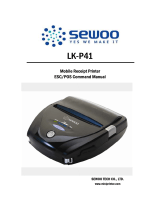
Contents
Overview .................................................................................................................................. 1
Purpose of this document .................................................................................................................. 1
Introduction ........................................................................................................................................ 1
Firmware Characteristics of the Controller ........................................................................................ 3
Line feed 3
Offline State ........................................................................................................................................ 4
Online / Offline State Diagram ....................................................................................................... 4
Operator Panel ................................................................................................................................... 5
Linefeed Button .............................................................................................................................. 5
Power LED Green ............................................................................................................................ 5
Paper End LED Yellow ..................................................................................................................... 5
Error LED Red .................................................................................................................................. 5
Sleep Mode ......................................................................................................................................... 6
Diagram of Power States TH230 / TH230+ ......................................................................................... 7
Programming Hints ............................................................................................................................. 8
Vertical Dot Lines ............................................................................................................................ 8
Horizontal Dot Lines ....................................................................................................................... 8
Reverse Feed after Cutting ............................................................................................................. 8
Small Graphics Printing ................................................................................................................... 8
Power off control by the host ......................................................................................................... 9
Page Mode Tips .................................................................................................................................. 9
Basic processing procedure for the page mode: .......................................................................... 10
Characteristics of the page mode ................................................................................................. 10
Absolute Origin of Graphics and Text in Page Mode ................................................................... 11
Barcode ......................................................................................................................................... 12
Control Sequences .................................................................................................................. 13
Control Characters and Control Sequences ..................................................................................... 13
Notation of the Command Description ............................................................................................ 13
Command Overview ......................................................................................................................... 14
Commands sorted by function groups ......................................................................................... 17
Ignored Commands .......................................................................................................................... 22
Description of the Control Characters and Sequences: ................................................................... 23
Transmit Status Identification Table .............................................................................................. 196
Printer Parameter Table ................................................................................................................. 197
Character Sets and Fonts ....................................................................................................... 199
Representation of the printed data ............................................................................................... 199
Character Fonts .......................................................................................................................... 199
User defined character sets ........................................................................................................ 200
Character code tables ................................................................................................................. 201
Standard code pages - tables ......................................................................................................... 206
Character code table Page 0 (PC437: USA, Standard Europe): .................................................. 206
Character code table Page 1 (PC850: Multilingual Latin I): ........................................................ 207
Character code table Page 2 (PC852: Latin II): ........................................................................... 208
Character code table Page 3 (PC860: Portuguese): ................................................................... 209























